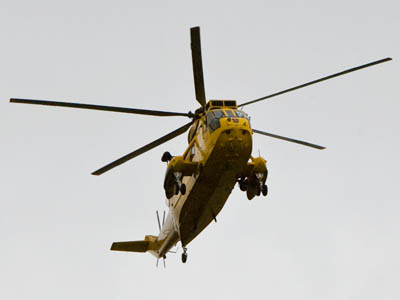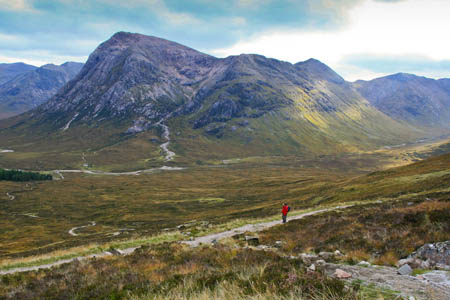
RAF Sea King helicopter crews from Lossiemouth and Royal Navy staff from HMS Gannet currently help mountain rescuers in the Highlands
Scotland could have its own civilian mountain rescue helicopter if a campaign is successful.
John Grieve, leader of the Glencoe Mountain Rescue Team, has been pushing for some time for an aircraft to help in rescues. At present, Sea King helicopters from RAF Lossiemouth and HMS Gannet attend mountain rescues when requested, but are likely to be diverted if military conditions dictate.
Mr Grieve, whose team, along with the neighbouring Lochaber rescue team, is one of the busiest in Scotland, said other organisations could also use the helicopter to help fund it.
The aircraft would most likely be based at Fort William, within a short flying distance of many of the peak rescue sites in the Highlands. A helicopter based at the base of Ben Nevis could be on the mountain within minutes, with the peaks of Glencoe within only ten minutes’ flying time and the Cairngorms, Oban, Torridon, Skye, and Killin teams’ areas half an hour away.

Glencoe: rescuers sometimes have to wait for more than an hour for helicopters to arrive
Mr Grieve told The Herald newspaper that, although the military search and rescue helicopter crews provide a welcome service to the volunteer rescue teams, his members often have to wait an hour or more for the RAF or RN craft to arrive at the scene.
He also said they will leave the scene if needed for military purposes elsewhere. He told the newspaper: “I remember on one occasion being lowered down on to the hillside, dangling in mid-air, when a call came through and I was just winched back up again and they were off.”
The Stornoway Coastguard helicopter, which often helps the Skye Mountain Rescue Team, is primarily designed for maritime rescue and its powerful downdraft can blow mountaineers off their feet.
The Scottish Government’s community safety minister Fergus Ewing has agreed to meet interested parties to hear their views. A business case would have to be made for the Government to finance a mountain rescue helicopter.
Civilian helicopters participate in mountain rescues in other European countries and charity-funded air ambulances assist throughout Britain, though they are not equipped with winches, so their scope in mountain rescue is limited. A Fort William-based helicopter would be a small craft rather than the Sikorsky S92 used by the Coastguard.
There are proposals to part-privatise the whole search and rescue helicopter operation in the UK from 2012.
Mr Grieve suggested police, fire and ambulance services, the Forestry Commission, Scottish Natural Heritage, Scottish Environment Protection Agency, and Scottish Water as potential partners in funding the helicopter, along with commercial operators such as fish farms.
Penelope Patricia Montgomery
29 January 2010Surely with the financial situation of the World the way it is at the moment, Mountain rescue, who remember, get £300,000 a year+ from the Scottish government at the moment should be grateful for the helicopter service they get. A small helicopter would be of no use it certainly wouldn't be able to winch anyone from a mountain side. As for funding from our emergency services surely they are over stretched and under budgeted as it is.
Marky H
25 February 2010Penny
It seems like you're not a mountaineer and haven't a clue on the subject to which you've commented!!!
Our Mountain Rescue Teams do a brilliant, un-paid, voluntary job looking after a range of people, from the idiots who wander up the mountains with a carrier bag of 'stuff' to the serious mountaineer whose accidents are reported here.
I believe that Mr Grieve knows what he's talking about, has 'our' health at heart and the tool of a locality based helicopter would not only greatly assist mountain rescue, but support the volunteers who come to our aide irrespective of the call.
I would further like to see Mountain Rescue announce a flat charge for rescue, discountable to £0 where the person being rescued has taken all the right precautions - at their discretion. This might then sharpen up people's attitudes to wandering up mountains ill-prepared, ill-equipped and thus reduce the number of pointless call-outs and subsequent 'strain' on all services called into play.
Tim Webber
31 March 2010...and will kill people who think they're going to get charged so don't call for help.
Very few of the people we rescue are true idiots.
Perhaps a a better triage system. "you're lost in the hills with a stove and a tent? ok pitch the tent and have a miserable but safe night until its daylight"
or "you've no torch but you do have a GPS - ok we'll send two people and a dog to guide you off rather than the whole team"
Jim Fraser
19 May 2010The government plans to provide helicopters for marine, land and aeronautical search and rescue across the UK and the very large area of ocean for which the UK has responsibility. That plan as it currently stands will involve using civilian and military aircrew flying Sikorsky S-92 aircraft. These will have the full range of operating capabilities that one expects from modern search and rescue helicopters and will have flying characteristics well in advance of Sea King and S-61 aircraft.
Some Scottish mountain areas, particularly Glencoe, are likely to be better served than before. This is partly because the S-92 is faster and partly because one base is moving nearer to the mountains. For example, at the published long range cruising speed of the S-92 (max speed is 20% faster), Glasgow-Abbotsinch to Altnafeadh in Glencoe takes 22 minutes (add 5 to 15 minutes for crew readiness times and ATC events).
According to a Sikorsky document dated 2003, the Total Direct Operating Cost for a S-92 used for offshore transport is $2381.00/hour. This is £1612/hour at today's exchange rate. This figure refers to flying hours and does not include the contractors overhead or the additional specialist capability that means that the cost for search and rescue is likely to be greater. The training load alone for such operations is immense.
At the same time that the new system for helicopter provision is being planned, an additional system of helicopter provision is being proposed for the area around Fort William. An additional service of this kind is likely to have a cost out of all proportion to its benefits. Alternatively, modifying the government plan would move the aircraft further from other important areas of provision around Glasgow, the Clyde, the Lakes and Northern Ireland and into an area with poor aeronautical conditions.